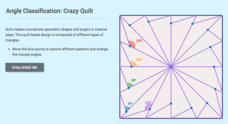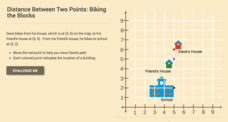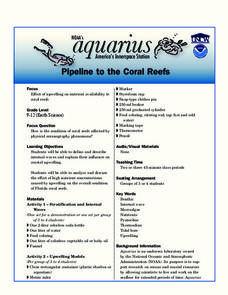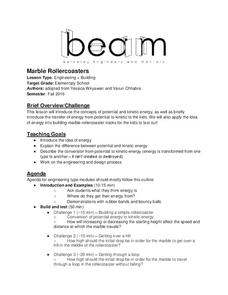CK-12 Foundation
Bisectors of Line Segments and Angles: Cut a Line
Geometric constructions build relationships —by simply manipulating simple tools. An interactive lesson presents a completed construction of a segment bisector and has learners analyze the important aspects. Ultimately, they should be...
Education Development Center
Interpreting Statistical Measures—Class Scores
Explore the effect of outliers through an analysis of mean, median, and standard deviation. Your classes examine and compare these measures for two groups. They must make sense of a group that has a higher mean but lower median compared...
CK-12 Foundation
Angle Measurement: Fuel Gauge Angles
Once you start looking, angles appear everywhere in our daily lives. A creative lesson has learners use the angles created by a fuel gauge to practice the Angle Addition Postulate. They see how changing the angle parts does not change...
CK-12 Foundation
Angle Measurement: Adding Angles
Build angles from angles. Using the Angle Addition Postulate, learners find the measures of unknown angles. The interactive simulation shows a visual representation of the postulate and allows individuals to manipulate the angles and...
CK-12 Foundation
Congruent Angles and Angle Bisectors: Bisecting Pepperoni Pizza
Who doesn't like pizza? A creative lesson uses a piece of pizza to explore angle bisectors and congruent angles. Young scholars work through a simulation to create congruent slices of pizza by analyzing an angle bisector. They then...
CK-12 Foundation
Angle Classification: Crazy Quilt
There's more to a quilt than just a pretty pattern—there's geometry! Explore angle classification using an artistic approach to show your class that quilt designs are really just intricate geometric patterns. Here, scholars create a...
CK-12 Foundation
Identification of Angles by Vertex and Ray
Angle ABC is not the same as angle BCA, but it is the same as angle CBA. Help your classes understand naming conventions of angles and, more importantly, the importance of naming angles correctly. Scholars practice the parts of the angle...
CK-12 Foundation
Points that Partition Line Segments: Cutting a Log
Teach ratios of line segments using an interactive approach. Scholars examine a line segment in the shape of a log and use their knowledge of ratios to divide it into various partitions. As an introductory lesson, the segment has a...
CK-12 Foundation
Distance Between Two Points: Biking the Blocks
Distance estimates would be easy if the world were a grid. Scholars work to determine the distance between two structures using a coordinate plane. As an introduction, the lesson focuses on vertical and horizontal distances.
CK-12 Foundation
Distance Between Two Points: Segment Addition
Examine the segment addition postulate through an online simulation activity. An interactive lesson allows scholars to manipulate points and watch as the lengths of segments change. Through their study, they are able to apply the Segment...
CK-12 Foundation
Midpoint and Segment Bisectors: Midpoint Map
Discover how to find a midpoint with a conceptual exploration. Scholars manipulate a point to determine the location of a midpoint on a straight line distance between two locations. Later questions extend to determine the location of...
University of Minnesota
Neurotransmission Model
Don't lose your marbles — you'll need them for a activity on neurotransmission. Young scholars build a neurotransmission model using marbles, beads, rubber bands, string, and other elements. After studying specific neurotransmitters,...
Florida International University
Are You Concentrating?
Explore the importance of a concentration gradient in the rates of dissolution. Using the ocean ecosystem, learners study rates of dissolution around coral reefs. A hands-on experiment helps individuals discover the effects of changing a...
University of Southern California
Design and Test an Air Lift Siphon
Build an air lift siphon using your mad physics skills! Learners first investigate the importance of circulating water in aquaponics systems. They then use density to their advantage as they engineer an air lift siphon
University of Southern California
Mastering Microbes
Small but mighty! Learners explore the role of microbes in a healthy ecosystem. An engaging lesson asks pupils to design an aquaponics system that demonstrates that healthy microbes are necessary to maintain the ecosystem.
Florida International University
The Good, the Bad and the Nasty Tasting
Examine the benefits of chemical defense mechanisms. Organisms in oceans use chemicals to ward off predators. Duplicate this adaptation using a hands-on experiment in which you ward off your predators (your pupils) with some bad-tasting...
Florida International University
Pipeline to the Coral Reefs
Discover firsthand the effects of internal waves on coral reefs. Through a series of experiments, learners simulate internal waves and upwelling events as they make observations on the movement of water and other debris. They then...
Florida International University
Designing an Autonomous Underwater Vehicle (AUV): Concepts in Lift, Drag, Thrust, Energy, Power, Mass, and Buoyancy
Engineer an autonomous underwater vehicle (AUV) to study concepts of physics. Using household materials, collaborative groups design and build an AUV and then test Newton's Laws of Motion as they apply them in underwater environments...
Nature Works Everywhere
Fishing for a Future
Teaching a man to fish has an environmental impact. Through a series of four lessons, learners study the science of fishery management. Their study involves analyzing data to develop a management strategy for specific fish and common...
Nature Works Everywhere
Sustainable Cities
Investigate aspects of sustainable cities and relate them to where you live! A detailed activity first investigates the definition of sustainability. Learners then explore human impact on the environment and social justice. Their final...
Cornell Lab of Ornithology
Life In A Nest: Exploring Life Cycles With Bird Cams
Why read about it when you can watch it happen? Bird cams make it possible for learners to experience the life cycle of a bird in real time! An engaging set of lessons provides activities to connect their learning to bird cam...
Cornell Lab of Ornithology
Investigating Evidence
Explore the scientific process through nature. Scholars become scientists as they develop a question, design an experiment, collect data, and analyze their results. A two-week lesson guides your classes through the process and provides...
University of California
Marble Rollercoasters
Don't let your classes coast through school! Engage them in their learning as they build their own roller coasters to study potential and kinetic energy. Young scholars complete several challenges that require them to consider the...
CK-12 Foundation
Alternate Formula for the Area of a Triangle: Alternate Area of a Triangle
It's always nice to have a plan B. Pupils investigate an alternate formula for the area of a triangle that uses sine. A set of challenge questions shows how the new formula relates to the well-known formula of (1/2)bh.

























